
4.1 Forces on Moving Charges in Magnetic Fields
6 min read•january 4, 2023
Peter Apps
Peter Apps
4.0: Overview
In previous units, we looked at how the electric field allows charged objects to interact without contact. In Unit 4, we'll take a look at , how they are created, and how they interact with electric fields. We'll cover how impact motion and interact with other .
makeup 17-23% of the AP exam and will take between 13 and 26 class periods to cover, depending on the length of the class period. In AP Classroom, you can check out the Unit 4 Personal Progress Check that has ~30 multiple choice questions and ~1 free response question for you to practice on.
4.1: Forces on Moving Charges in a Magnetic Field
What Does a Magnetic Field Look Like?
You may remember playing with magnets in elementary school, using a compass or iron filings to show the shape of the field. Magnetic field lines show the direction that the north pole of a magnet will be pushed or pulled. Just like electric charges, we can use the rule "likes repel, opposites attract". So, a north pole will repel other north poles and be attracted to south poles. Also, like electric fields, we can tell the strength of the field visually by looking at how close the lines are together.
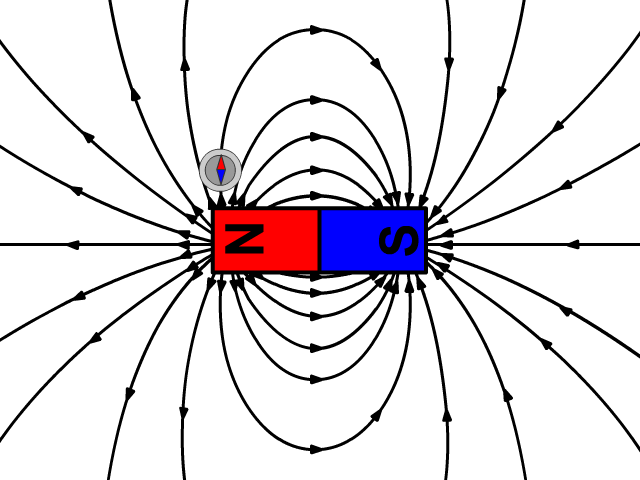
Image from stickmanphysics.com
The Earth also produces a magnetic field that protects us from a variety of cosmic radiation. The charged particles from the solar wind spiral along the magnetic field lines and collect around the poles resulting in auroras. In order for this to occur, particles need to be charged to be affected by the Earth's magnetic field.

Image from wikipedia.com
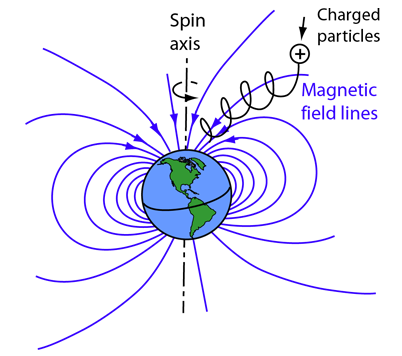
Image from hyperphysics.phy-astr.gsu.edu/
Magnetic field strength is represented by B and has units of Tesla (T) where 1T = {Ns}/{Cm}. (Aren't you happy we can just write Tesla instead of Newton second per Coulomb meter? I am! 😄)
Magnetic Force & the Right Hand Rule for Magnetic Fields
So, why do charged particles curve in a magnetic field? They experience a force! The force from a magnetic field can be calculated using this equation:

Looking at this equation, we can see that in order to be affected by a magnetic force:
- The object must be charged q =/= 0
- The particle must be moving v =/= 0
- There must be a magnetic field B =/= 0
- The particle and the field must have a perpendicular component (cross product)
Ok, so we can calculate the magnitude of the force, but what about its direction? This can be easily found using the Right-Hand Rule (RHR). Point your thumb in the direction a positive charge is moving, your other fingers in the direction of the magnetic field, and your palm will face the direction of the force.
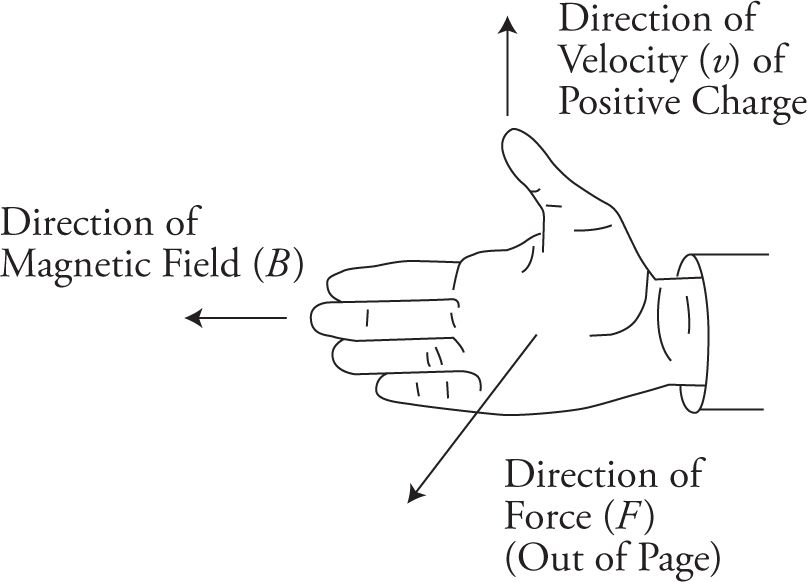
Image from schoolbag.info
Based on the way that the magnetic field is pointing or the way that charge is moving, you may use a Right-Hand Rule that your teacher taught you that looks more like a thumbs up 👍 or like an xyz plane with your middle finger pointing up in the air (😳) while your thumb points to the right and your pointer finger goes forward. The image above though is the best and most commonly used RHR, but the others are still valid choices based on the movement of charges!
Paths of Charged Objects
Because the magnetic force will always be perpendicular to the velocity of the moving charge, the field will cause the particle to curve as it moves. While there are many cases where the motion is not uniform circular motion (UCM), a majority of the questions involving calculations will assume that it is UCM. (For a review of this, check out this Fiveable Study Guide)
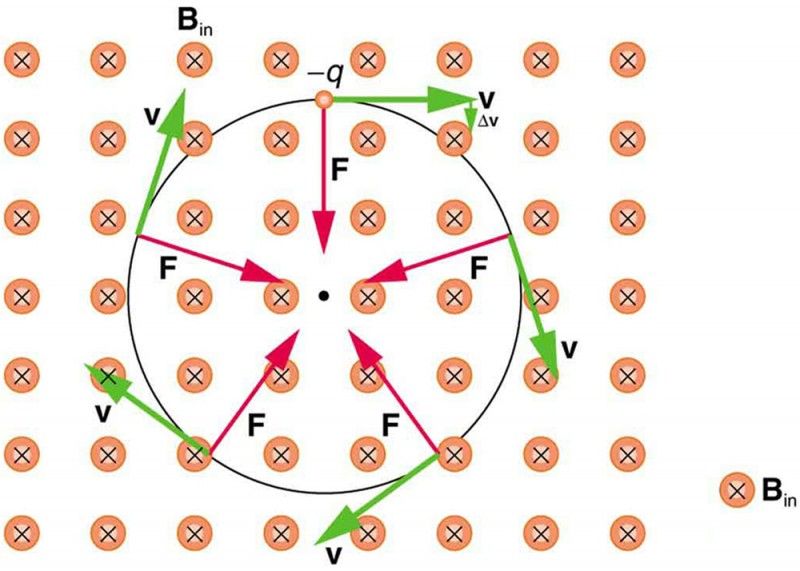
Image from courses.lumenlearning.com/
This concept is incredibly useful for detecting and directing moving charged particles. It's used in everything from old-style TVs to particle accelerators. A inside an old tv used to steer a beam of electrons to an exact spot on the screen where they would hit a fluorescent material and produce color.
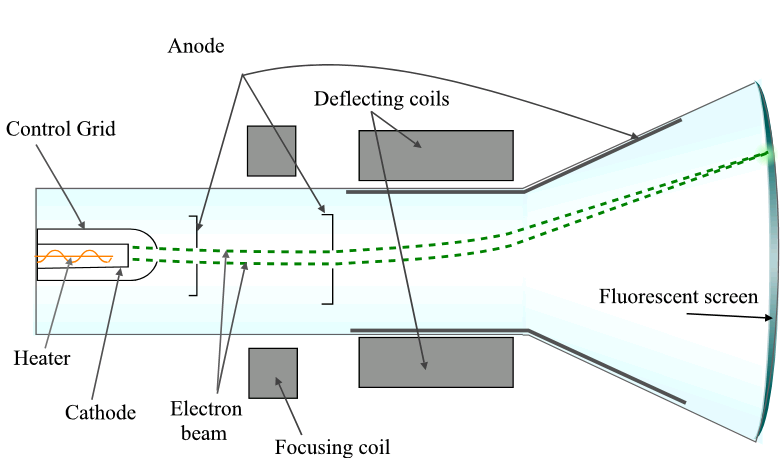
Image from wikipedia.org
Physicists also use to help identify the particles created after a collision inside a . In the image below the green CCW spiral is an electron, and the purple CW spiral is its antiparticle, a positron.
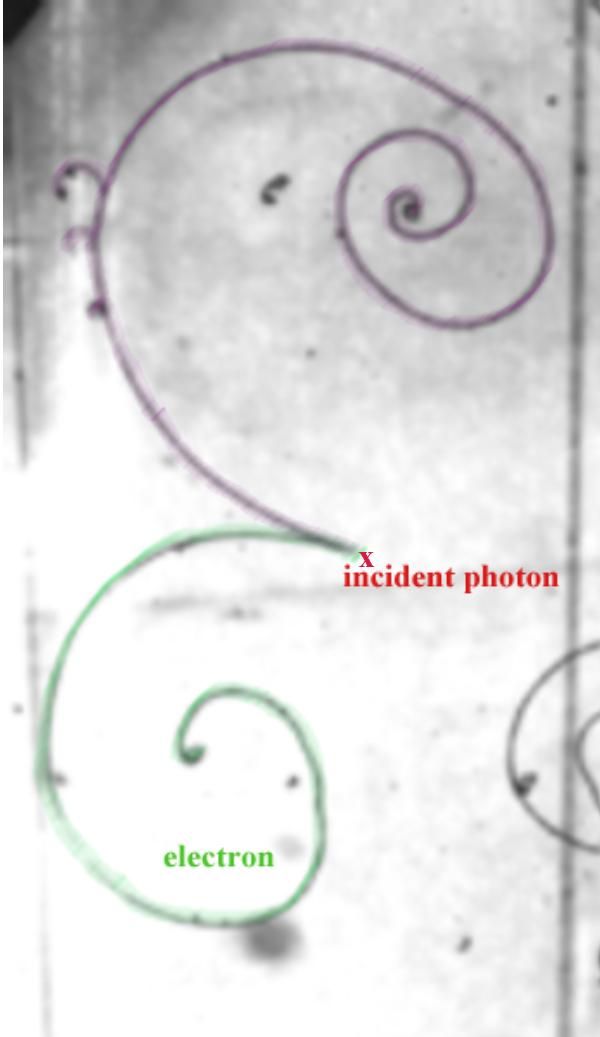
Image from hst-archive.web.cern.ch/
Magnetic & Electric Field Interactions
There are also useful devices that use both electric and to exert two different forces on the charged particle. For example, the cathode ray tube in an old TV would use to steer the electrons vertically and electric fields to steer the beam horizontally allowing for an exact x,y position to be targeted.
These fields can also be aligned so that the two forces are opposing each other, allowing the particles to travel in a straight line. Devices, such as a , use varying electric fields and to allow only particles with a certain velocity to pass through without deflecting.
The particles then enter a region with only a magnetic field, causing them to undergo UCM. The radius of the path allows scientists to determine the mass of the particle and understand more about the chemical makeup of the source material.
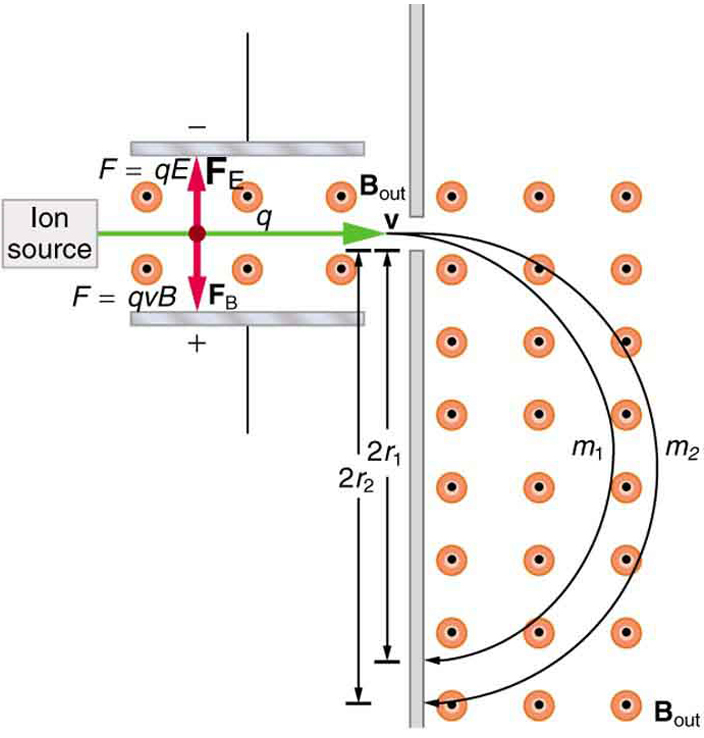
Image from openstax.org

Practice Questions
1)
Two plates are set up with a V between them. A small sphere of mass m and charge -e is placed at the left-hand plate, which has a negative charge, and is allowed to accelerate across the space between the plates and pass thourgh a small opening. After passing through the small opening, the sphere enters a region in which there is a of magnitude B directed into the page, as shown above. Ignore gravitational effects. Express all algebraic answers in terms of V, m, e, B, and fundamental constants, as appropriate.
(a) i. What is the initial direction of the force on the sphere as it enters the magnetic field? (Check one.)
_ Into the page, _ Out of the page, _ Towards the top of the page, _ Towards the bottom of the page
ii. Describe the path taken by the sphere after it enters the magnetic field.
(b) Derive an expression for the speed of the sphere as it passes through the small opening.
(c) Derive an expression for the radius of the path taken by the sphere as it moves through the magnetic field.

Answers
a) i. Towards the bottom of the page. Use the RHR, then remember that the RHR is for positive charged objects, so switch the direction of the force because we have an electron.
ii. With a net force pushing towards the bottom of the page, the particle will travel in a circular path curving towards the bottom of the page.
b)
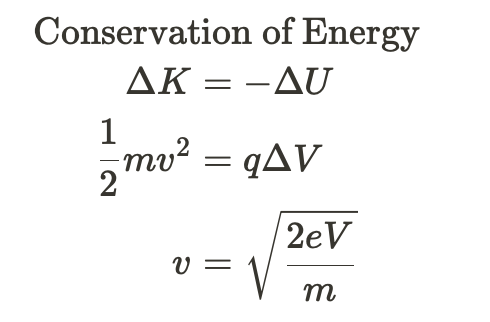
c)

2)

Image from apclassroom.collegeboard.org
The figure above shows the paths of five particles as they pass through the region inside the box that contains a B directed out of the page. Which particle has a positive charge?
Answer
Use the RHR with your fingers pointing out of the page.
A - Force is directed upwards, but shows a downward curve. A must be negatively charged
B - Force is directed downwards, and the curve is downwards. B must be positively charged
C - Same as A, must be negatively charged
D - Force is downwards, curve is upwards. D must be negative as well
E - No curve, so no charge. E is neutral
Key Terms to Review (8)
Cathode-ray tube
: A cathode-ray tube is a vacuum tube that uses an electron beam to create images on a fluorescent screen. It consists of an electron gun, deflection plates, and a phosphorescent screen.Charge (-e)
: Charge refers to one of the fundamental properties of matter that determines how objects interact with electromagnetic fields. A negative charge (-e) indicates an excess or deficit of electrons compared to protons within an object.Magnetic Fields
: Magnetic fields are regions in space where magnetic forces can be detected. They are created by moving electric charges and exert a force on other moving charges or magnetic materials.Mass spectrometer
: A mass spectrometer is an analytical instrument used to measure the masses and relative abundances of atoms or molecules in samples. It works by ionizing the sample, separating ions based on their mass-to-charge ratio, and detecting them with sensors.Particle accelerator
: A particle accelerator is a scientific instrument used to accelerate charged particles, such as protons or electrons, to high speeds. It uses electric fields and magnetic fields to propel particles and increase their energy.Potential Difference
: Potential difference, also known as voltage, is the difference in electric potential energy per unit charge between two points in an electric circuit. It represents how much work is done on each unit of charge when it moves from one point to another.Uniform Circular Motion (UCM)
: Uniform circular motion refers to the motion of an object moving in a circle at a constant speed. The object experiences a continuous change in direction but its speed remains constant.Uniform magnetic field
: A uniform magnetic field refers to a region in space where the magnetic field strength and direction remain constant.4.1 Forces on Moving Charges in Magnetic Fields
6 min read•january 4, 2023
Peter Apps
Peter Apps
4.0: Overview
In previous units, we looked at how the electric field allows charged objects to interact without contact. In Unit 4, we'll take a look at , how they are created, and how they interact with electric fields. We'll cover how impact motion and interact with other .
makeup 17-23% of the AP exam and will take between 13 and 26 class periods to cover, depending on the length of the class period. In AP Classroom, you can check out the Unit 4 Personal Progress Check that has ~30 multiple choice questions and ~1 free response question for you to practice on.
4.1: Forces on Moving Charges in a Magnetic Field
What Does a Magnetic Field Look Like?
You may remember playing with magnets in elementary school, using a compass or iron filings to show the shape of the field. Magnetic field lines show the direction that the north pole of a magnet will be pushed or pulled. Just like electric charges, we can use the rule "likes repel, opposites attract". So, a north pole will repel other north poles and be attracted to south poles. Also, like electric fields, we can tell the strength of the field visually by looking at how close the lines are together.

Image from stickmanphysics.com
The Earth also produces a magnetic field that protects us from a variety of cosmic radiation. The charged particles from the solar wind spiral along the magnetic field lines and collect around the poles resulting in auroras. In order for this to occur, particles need to be charged to be affected by the Earth's magnetic field.

Image from wikipedia.com

Image from hyperphysics.phy-astr.gsu.edu/
Magnetic field strength is represented by B and has units of Tesla (T) where 1T = {Ns}/{Cm}. (Aren't you happy we can just write Tesla instead of Newton second per Coulomb meter? I am! 😄)
Magnetic Force & the Right Hand Rule for Magnetic Fields
So, why do charged particles curve in a magnetic field? They experience a force! The force from a magnetic field can be calculated using this equation:

Looking at this equation, we can see that in order to be affected by a magnetic force:
- The object must be charged q =/= 0
- The particle must be moving v =/= 0
- There must be a magnetic field B =/= 0
- The particle and the field must have a perpendicular component (cross product)
Ok, so we can calculate the magnitude of the force, but what about its direction? This can be easily found using the Right-Hand Rule (RHR). Point your thumb in the direction a positive charge is moving, your other fingers in the direction of the magnetic field, and your palm will face the direction of the force.

Image from schoolbag.info
Based on the way that the magnetic field is pointing or the way that charge is moving, you may use a Right-Hand Rule that your teacher taught you that looks more like a thumbs up 👍 or like an xyz plane with your middle finger pointing up in the air (😳) while your thumb points to the right and your pointer finger goes forward. The image above though is the best and most commonly used RHR, but the others are still valid choices based on the movement of charges!
Paths of Charged Objects
Because the magnetic force will always be perpendicular to the velocity of the moving charge, the field will cause the particle to curve as it moves. While there are many cases where the motion is not uniform circular motion (UCM), a majority of the questions involving calculations will assume that it is UCM. (For a review of this, check out this Fiveable Study Guide)

Image from courses.lumenlearning.com/
This concept is incredibly useful for detecting and directing moving charged particles. It's used in everything from old-style TVs to particle accelerators. A inside an old tv used to steer a beam of electrons to an exact spot on the screen where they would hit a fluorescent material and produce color.

Image from wikipedia.org
Physicists also use to help identify the particles created after a collision inside a . In the image below the green CCW spiral is an electron, and the purple CW spiral is its antiparticle, a positron.

Image from hst-archive.web.cern.ch/
Magnetic & Electric Field Interactions
There are also useful devices that use both electric and to exert two different forces on the charged particle. For example, the cathode ray tube in an old TV would use to steer the electrons vertically and electric fields to steer the beam horizontally allowing for an exact x,y position to be targeted.
These fields can also be aligned so that the two forces are opposing each other, allowing the particles to travel in a straight line. Devices, such as a , use varying electric fields and to allow only particles with a certain velocity to pass through without deflecting.
The particles then enter a region with only a magnetic field, causing them to undergo UCM. The radius of the path allows scientists to determine the mass of the particle and understand more about the chemical makeup of the source material.

Image from openstax.org

Practice Questions
1)
Two plates are set up with a V between them. A small sphere of mass m and charge -e is placed at the left-hand plate, which has a negative charge, and is allowed to accelerate across the space between the plates and pass thourgh a small opening. After passing through the small opening, the sphere enters a region in which there is a of magnitude B directed into the page, as shown above. Ignore gravitational effects. Express all algebraic answers in terms of V, m, e, B, and fundamental constants, as appropriate.
(a) i. What is the initial direction of the force on the sphere as it enters the magnetic field? (Check one.)
_ Into the page, _ Out of the page, _ Towards the top of the page, _ Towards the bottom of the page
ii. Describe the path taken by the sphere after it enters the magnetic field.
(b) Derive an expression for the speed of the sphere as it passes through the small opening.
(c) Derive an expression for the radius of the path taken by the sphere as it moves through the magnetic field.

Answers
a) i. Towards the bottom of the page. Use the RHR, then remember that the RHR is for positive charged objects, so switch the direction of the force because we have an electron.
ii. With a net force pushing towards the bottom of the page, the particle will travel in a circular path curving towards the bottom of the page.
b)

c)

2)

Image from apclassroom.collegeboard.org
The figure above shows the paths of five particles as they pass through the region inside the box that contains a B directed out of the page. Which particle has a positive charge?
Answer
Use the RHR with your fingers pointing out of the page.
A - Force is directed upwards, but shows a downward curve. A must be negatively charged
B - Force is directed downwards, and the curve is downwards. B must be positively charged
C - Same as A, must be negatively charged
D - Force is downwards, curve is upwards. D must be negative as well
E - No curve, so no charge. E is neutral
Key Terms to Review (8)
Cathode-ray tube
: A cathode-ray tube is a vacuum tube that uses an electron beam to create images on a fluorescent screen. It consists of an electron gun, deflection plates, and a phosphorescent screen.Charge (-e)
: Charge refers to one of the fundamental properties of matter that determines how objects interact with electromagnetic fields. A negative charge (-e) indicates an excess or deficit of electrons compared to protons within an object.Magnetic Fields
: Magnetic fields are regions in space where magnetic forces can be detected. They are created by moving electric charges and exert a force on other moving charges or magnetic materials.Mass spectrometer
: A mass spectrometer is an analytical instrument used to measure the masses and relative abundances of atoms or molecules in samples. It works by ionizing the sample, separating ions based on their mass-to-charge ratio, and detecting them with sensors.Particle accelerator
: A particle accelerator is a scientific instrument used to accelerate charged particles, such as protons or electrons, to high speeds. It uses electric fields and magnetic fields to propel particles and increase their energy.Potential Difference
: Potential difference, also known as voltage, is the difference in electric potential energy per unit charge between two points in an electric circuit. It represents how much work is done on each unit of charge when it moves from one point to another.Uniform Circular Motion (UCM)
: Uniform circular motion refers to the motion of an object moving in a circle at a constant speed. The object experiences a continuous change in direction but its speed remains constant.Uniform magnetic field
: A uniform magnetic field refers to a region in space where the magnetic field strength and direction remain constant.
Resources
© 2024 Fiveable Inc. All rights reserved.
AP® and SAT® are trademarks registered by the College Board, which is not affiliated with, and does not endorse this website.